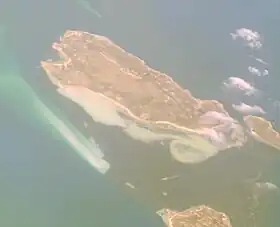Anderson Island (Tasmania)
The Anderson Island, also known as Woody Island, part of the Tin Kettle Island Group of the Furneaux Group, is a 166-hectare (410-acre) granite island, located in Bass Strait, lying northeast of Tasmania, in south-eastern Australia.[1] Anderson Island lies between Flinders and Cape Barren Islands and is partly a pastoral lease used for grazing sheep and cattle. The island is joined at low tide to nearby Little Anderson and Tin Kettle Islands by extensive intertidal mudflats.[2] The island is supposed to be named after John Anderson, a sealer living on the island by 1842.[3]
 Anderson Island | |
 Location of Anderson Island in Bass Strait | |
| Geography | |
|---|---|
| Location | Bass Strait |
| Coordinates | 40°18′10″S 148°06′35″E |
| Archipelago | Furneaux Group |
| Area | 1.66 km2 (0.64 sq mi) |
| Administration | |
Australia | |
| State | Tasmania |
| LGA | Municipality of Flinders Island |
| Demographics | |
| Population | 0 (2018) |
The island is part of the Franklin Sound Islands Important Bird Area, identified as such by BirdLife International because it holds over 1% of the world populations of six bird species.[4]
History
“Sealers,” and their Aboriginal partners, are reported living, intermittently, on the island from the 1820s. When Robinson visited the island in November 1830, he found there George Robinson (no relation) and James Everett and their Aboriginal “wives.”[5] Captain Pasco of the survey vessel Vansittart visited in 1842 and found John Anderson (alias “Abyssinia Jack”) in residence with his family.[5] When the Isabella of Leith was wrecked on the coast of Flinders Island in 1844, thirteen of the passengers and crew reached Anderson Island in a long boat where they were given shelter by the sealers.[6]
Flora and fauna
Most of the island's original vegetation has disappeared, replaced by pasture for livestock. There are a few remnant patches of Melaleuca and Stipa around the coast.
Recorded breeding seabird and wader species are little penguin, Pacific gull, sooty oystercatcher and pied oystercatcher. There used to be a large short-tailed shearwater colony on the western side of the island until the early 20th century, when it was destroyed through the introduction of pigs, which dug up the burrows and ate the eggs and chicks. The metallic skink is present.[2]
Proposals
In 2017 it was proposed that houses were built on Anderson Island, due to the conservation status though this never occurred as it would likely damage the sooty oystercatcher colony. This would have been devastating for the species. The proposal was to include parks, beaches, shops, schools and room for 500 people, significantly upping the population of the Flinders Island Region.
References
- "Anderson Island (TAS)". Gazetteer of Australia online. Geoscience Australia, Australian Government.
- Brothers, Nigel; Pemberton, David; Pryor, Helen; & Halley, Vanessa. (2001). Tasmania’s Offshore Islands: seabirds and other natural features. Tasmanian Museum and Art Gallery: Hobart. ISBN 0-7246-4816-X
- Kostoglou, Parry (1996). Sealing in Tasmania (First ed.). Hobart: Parks and Wildlife Service. p. 102.
- "BirdLife Data Zone Franklin Sound Islands". BirdLife International. Retrieved 26 May 2017.
- Kostoglou, p.103.
- Kostoglou, p.103-4.